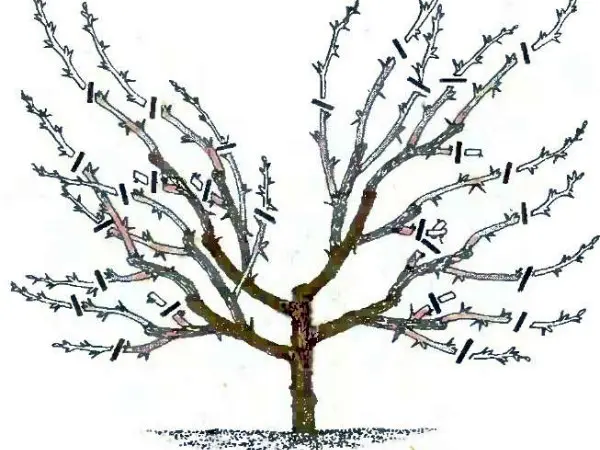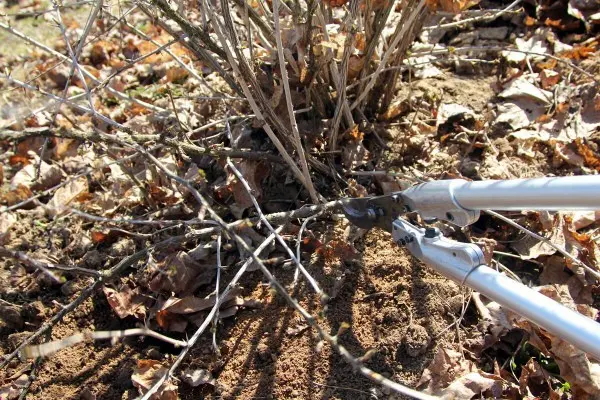Contents


All plants in your garden require some form of care that will not only help them survive, but also enhance their performance. Pruning gooseberries, for example, significantly increases its yield and immunity, allowing it to withstand more pests. In this article, we will look at how gooseberries are pruned in the fall, when exactly it is necessary to form a bush, and we will also provide detailed instructions for beginner gardeners.
Инструментарий
Before starting the formation of a gooseberry bush, you should prepare the tools, as well as protective elements, because the gooseberry is famous for its ubiquitous thorns, which you can get hurt on. You will need thick, wide-cuffed mittens, or regular gardening gloves, and a jacket or cardigan made of thick fabric to protect your hands from scratches and cuts. You need to trim the bushes with an ordinary garden pruner. However, a garden saw or scissors with long handles, which are used for cutting branches, will do. You also need lime or paint to mark the branches and their length for pruning.

Step by step pruning instructions
Gooseberry pruning is carried out twice a year, depending on the convenience of the gardener. Spring pruning of the bush is carried out after the snow melts, but before the buds appear on the branches. That is why pruning is less common in spring. It is more convenient to care for gooseberries in the fall, after harvesting. Having dealt with the time and features of pruning in spring and autumn, you can proceed to the instructions – how to prune gooseberries.
First of all, it should be noted that there is more than one pruning scheme, since gooseberries can be grown in different ways. There are such types of it:
- on the stem, that is, in the form of a small tree, they leave the strongest shoot, which will be the trunk, and remove all side shoots;
- on a trellis – this method is suitable for varieties that are characterized by lodging bushes;
- classic – does not imply additional devices and manipulations.

Schematic representation of a gooseberry pruning
The least time-consuming and effortless is the classic gooseberry pruning. In the first year, the branches of the bush are shortened by a third, of all the formed shoots, 3 of the strongest and most promising are left. In the second year, it is again necessary to shorten the lashes by a third, but leave more root shoots – about 6-7. In the third year, fresh shoots are shortened and thinned out. Annual pruning of the bush has a positive effect on the quality and quantity of the crop, and in some cases helps to speed up the harvest time. This pruning is carried out in the spring.
In autumn, bush care begins after harvesting and leaf fall. You need to carefully examine the bush, noting those branches that have grown old or withered. This can be determined by the state of the bark and its color – the old branches are almost completely black. Note also competing branches and those that grow too close to the ground.

First of all, the branches and shoots located at the bottom of the bush are cut off in order to improve the overview of the rest of the working area. Then you need to select 3 large branches, since more cannot be cut at a time so as not to harm the gooseberries. But the root shoots must be removed completely, since they only draw on nutrient resources. After working with a pruner, the sections must be properly processed – usually garden pitch is used for this.
Properly carried out care allows you to notice an improvement in the growth of gooseberries next spring, and after and in the fall, when it’s time to harvest.
Actions after trimming
Once you’ve finished pruning your bushes, gooseberries will need some maintenance. After all, whatever one may say, you caused him significant damage by removing some of the branches and shoots. Care consists in properly carried out top dressing, tillage and watering.

After fruiting, gooseberry bushes are extremely weakened, so good feeding is important for them to survive the winter. It is recommended to add at least 15 kilograms of humus, compost or rotted manure under each bush. However, it will not be superfluous to add mineral elements. Add 200 grams of superphosphate and 40 grams of potassium to organic fertilizer. This will be enough so that the bushes do not suffer when the first frosts come.
Soil tillage in the fall is one of the most important preventive moments. As is known, most fungal microorganisms tolerate low temperatures well in the upper soil layers and plant residues. Insect pests are no less winter hardy. Therefore, it is important, when plant residues are removed from the beds, to carefully dig the ground. It is worth doing this carefully and correctly, trying not to turn care into torture. Aisles are dug up on a spade bayonet, the gaps between plants – to a depth of no more than 10 centimeters, and in the trunk circle around the gooseberry – no deeper than 5 centimeters. The dug up earth must be treated with fungicides and insecticides of complex action, and then mulched with peat.
Watering is another important element that completes the autumn gooseberry care. It will be correct to pour water into the near-stem circle so that it has time to be absorbed.
Under each bush, you need to add 15-20 liters of water – this is quite enough to prepare the plant for winter.
Video “Autumn pruning of a gooseberry bush”
From this video you will learn why autumn pruning is needed, how it is done correctly.
Author: Svetlana Galitsina
Loading…









